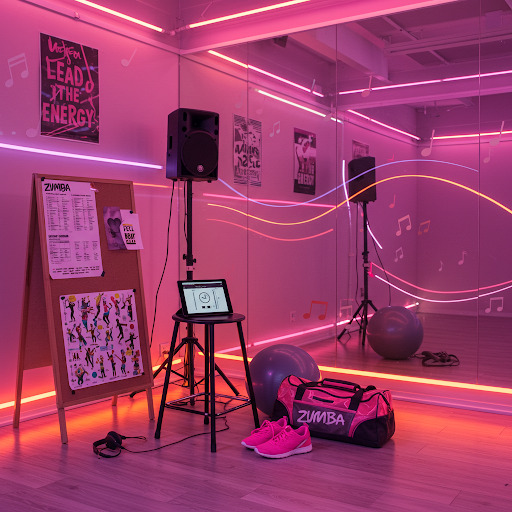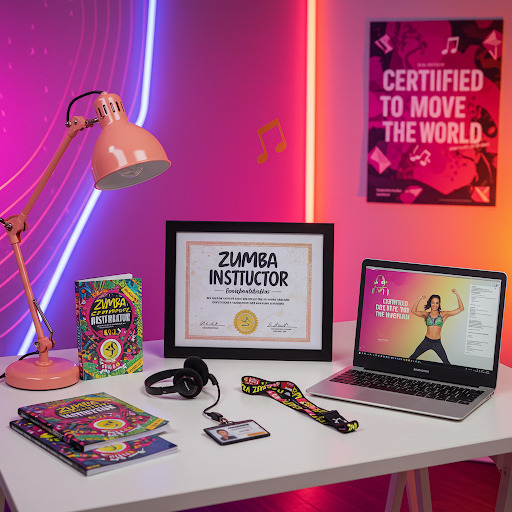Are you ready to ignite your passion for fitness and transform your body with an energetic and fun workout? Imagine a fitness program that combines Latin and international rhythms with easy-to-follow dance moves, making exercise feel less like a chore and more like a dance party.

Zumba has revolutionized the way we think about exercise, evolving from a single class into a global phenomenon with millions of participants worldwide. As a fitness program accessible to people of all ages, fitness levels, and dance abilities, it promotes a lifestyle of joy, community, and holistic wellness. Whether you’re a seasoned dancer or a beginner, Zumba classes offer a dynamic and exciting way to improve your physical and mental health.
Key Takeaways
- Discover the benefits of Zumba for physical and mental well-being
- Learn how to get started with Zumba classes as a beginner
- Explore advanced Zumba training options for instructors
- Understand the process of becoming a certified Zumba instructor
- Find out how Zumba can be adapted to different fitness levels and ages
What Is Zumba Training?
With its roots in Latin dance, Zumba has evolved into a diverse fitness program that caters to a wide range of ages and fitness levels. At its core, Zumba combines energetic music with easy-to-follow dance moves, creating an engaging and effective workout.
The Origins and Evolution of Zumba
Zumba originated in the 1990s, drawing inspiration from Latin dance styles such as salsa, merengue, and cumbia. Over the years, it has evolved to incorporate various other dance styles, including hip-hop and reggaeton. This evolution has enabled Zumba to stay fresh and exciting, appealing to a broad audience. The program’s adaptability has been key to its global success.
The diversity in Zumba’s dance styles is a significant factor in its widespread appeal. From salsa to hip-hop, the variety of dance styles employed in Zumba classes is as diverse as the instructors who teach them.
Different Types of Zumba Classes
Today, there are several formats of Zumba classes available, catering to different demographics and fitness goals. These include traditional Zumba, Zumba Gold for older adults, Zumba Toning for those looking to improve muscle tone, Aqua Zumba for a water-based workout, and Zumba Kids for children. Each format maintains the core Zumba experience while targeting specific needs and preferences.
Participants can expect a dynamic class structure that includes a mix of music and dance styles. The intensity levels can vary depending on the instructor and the specific class format. Different studios may offer classes that vary in style, energy, and focus, allowing participants to find the perfect fit for their fitness level and personal preferences.
Cardiovascular and Strength Benefits
Zumba training is an effective way to enhance cardiovascular fitness through its dynamic dance routines. As participants follow the zumba instructor, they engage in aerobic exercise that strengthens the heart and improves circulation. Additionally, the resistance movements incorporated into Zumba choreography help build muscular strength and endurance.
Weight Management and Toning
Zumba can help with weight management through its calorie-burning dance routines, while also toning muscles through resistance movements. Regular participation in Zumba classes can lead to a more balanced physique and improved overall fitness. As an instructor guides the class, participants can achieve their fitness goals in a supportive environment.

Stress Relief and Mental Health Advantages
The upbeat music and dance movements in Zumba trigger the release of endorphins, creating a natural mood boost. The social aspect of Zumba classes fosters community connections, combating isolation and loneliness. By focusing on dance movements, participants experience a mental break from daily stressors, akin to a form of moving meditation. Mastering new dance steps builds confidence and self-esteem, extending beyond the classroom. Research highlights that dance-based exercise programs like Zumba can reduce symptoms of anxiety and depression, promoting mental well-being in a judgment-free zone.
Getting Started with Zumba Training
Embarking on a Zumba journey can be an exhilarating experience, offering a fun and dynamic way to improve your fitness. As you prepare to join your first class, there are a few things to consider to ensure a smooth and enjoyable experience.
What to Wear and Bring to Your First Class
When attending your first Zumba class, wear comfortable clothing that allows for a full range of motion and is breathable. Moisture-wicking fabrics are ideal as they help keep you dry throughout the high-energy workout. Good quality workout shoes with adequate arch support and cushioning are also essential. As for what to bring, a towel, water bottle, and a positive attitude are must-haves.

Finding the Right Zumba Training Class for Your Fitness Level
To find a Zumba class that suits your fitness level, start by researching local offerings through gym websites, dedicated Zumba studios, and the official Zumba website. Evaluate class descriptions to determine if they’re geared towards beginners, intermediate, or advanced participants. It’s advisable to try classes at different studios to experience various teaching styles and find an instructor whose energy resonates with you. Before joining a class, ask about the intensity level, modifications offered, and class size. If you’re new to dance fitness, consider starting with beginner-friendly formats like Zumba Gold or basic Zumba. Remember, zumba instructors should always offer modifications, making any class potentially suitable with the right adjustments.
| Class Type | Description | Intensity Level |
|---|---|---|
| Zumba Gold | Aged-based class focusing on balance, strength, and flexibility | Low to Moderate |
| Basic Zumba | Introductory class teaching fundamental Zumba moves | Moderate |
| Zumba Toning | Class using toning sticks to add resistance to the workout | Moderate to High |
The Path to Becoming a Zumba Instructor

The journey to becoming a licensed Zumba instructor involves a comprehensive training process. This process is designed to equip aspiring instructors with the knowledge, skills, and confidence needed to lead high-energy Zumba classes.
Zumba Basic1 Training Requirements
To start, one must register for the Zumba Basic1 training, which is the foundational certification course. This training is typically completed within ten hours to two days, depending on the pace. It’s essential to consider your health condition and availability before signing up.
Registration Process and Costs
The registration process for Zumba Basic1 training involves signing up through the official Zumba website or an authorized training center. The cost varies depending on the location and the training center. It’s crucial to check what’s included in the cost, such as instructor manuals, music, and choreography resources.
What to Expect During Certification
During the certification process, participants can expect a mix of theoretical learning and practical application. The training covers the basics of Zumba, including dance techniques and teaching methods. To complete Zumba certification, instructors must demonstrate their understanding and ability to teach Zumba effectively.
After becoming zumba certified, instructors receive their license and gain access to a wealth of resources, including ongoing support and mentor connections. This support is invaluable for becoming zumba a successful instructor, as it helps navigate the challenges of teaching and continuing education in the field of instructor training.
Building Dance and Fitness Proficiency
To teach Zumba effectively, you need to have a good level of dance and fitness proficiency. This can be achieved by regularly practicing Zumba choreography and staying updated with the latest trends and techniques. Participating in Zumba classes and workshops can also help you improve your skills and gain confidence.
Effective Communication Techniques
Effective communication is crucial for a Zumba instructor. You need to be able to clearly explain the choreography, provide feedback, and create a positive and supportive atmosphere. Using simple and concise language, making eye contact, and varying your tone of voice are some techniques that can help you communicate effectively with your participants.
Creating Engaging Choreography
Creating engaging choreography is essential to keeping your participants motivated and interested. You can achieve this by incorporating a variety of dance styles, such as salsa, cumbia, and reggaeton, into your routines. It’s also important to consider the fitness level and preferences of your participants when designing your choreography.

By combining your dance and fitness proficiency, effective communication techniques, and engaging choreography, you can develop a unique teaching style that sets you apart as a Zumba instructor.
Advanced Zumba Training and Specializations
Elevate your Zumba instruction with specialized training programs designed for diverse demographics and environments. As a Zumba instructor, advancing your training can significantly enhance your teaching capabilities and open up new opportunities.
Zumba Gold for Seniors
Zumba Gold is tailored for older adults, focusing on low-impact movements that improve cardiovascular health and flexibility. This specialization requires understanding the needs of older demographics and adapting teaching Zumba techniques accordingly.
Zumba Kids and Zumba Toning
Zumba Kids is designed for children, promoting fun and energetic workouts. Zumba Toning focuses on strength training using light weights. Both formats demand unique zumba instruction approaches, catering to different age groups and fitness goals.
Aqua Zumba and Other Variations
Aqua Zumba adapts traditional Zumba movements for the water environment, creating a low-impact yet challenging workout. Other variations include Zumba Step, Zumba Sentao, and STRONG by Zumba. Each requires specific training and certification beyond the basic instructor credential, allowing Zumba instructors to diversify their teaching portfolio.
By pursuing these specializations, instructors can differentiate themselves in the competitive fitness market, potentially leading to a more diverse and sustainable teaching schedule.
Building Your Zumba Business
Building a thriving Zumba business requires careful planning and strategic decision-making. As a certified Zumba instructor, you have the foundation to succeed, but you need to consider several factors to establish a strong presence in the fitness industry.
Joining the Zumba Instructor Network (ZIN)
Joining the Zumba Instructor Network (ZIN) is a crucial step in building your Zumba business. ZIN membership provides access to a wealth of resources, including the latest choreography, marketing materials, and networking opportunities with other instructors.

Marketing Your Zumba Classes
Effective marketing is essential to attract and retain clients for your Zumba classes. Utilize social media platforms, local fitness communities, and promotional materials to showcase your unique teaching style and the benefits of Zumba.
Choosing Between Gym Employment and Independent Teaching
Deciding whether to teach at a gym or operate independently is a critical decision for your Zumba business. Teaching at a gym offers a ready-made clientele and lower startup costs, but may limit your flexibility and autonomy. On the other hand, independent teaching allows you to set your schedule, choose your class formats, and build your brand.
Consider the pros and cons of each option, including financial considerations, marketing support, and legal requirements. A hybrid approach, combining both facility-based and independent teaching, can also be a viable strategy to maximize income and exposure.
Conclusion: Embracing the Zumba Lifestyle
Embracing the Zumba lifestyle means embracing a journey of continuous learning, growth, and self-improvement. As a Zumba instructor, staying updated with the latest trends and maintaining an active Zumba license is crucial for long-term success.
The benefits of Zumba training are multifaceted, offering physical, mental, and social advantages for both participants and instructors. By pursuing ongoing Zumba instructor training and specialization, you can enhance your teaching skills and provide more value to your students.
Whether you’re looking to attend your first Zumba class or pursue instructor certification, now is the time to take the next step. Visit our website or check out our page to learn more about getting started with Zumba training.




